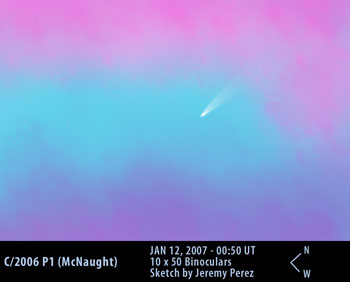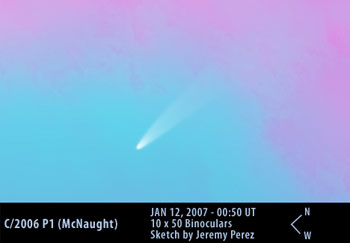

Observation Notes
On the slight chance the weather would cooperate, I headed up to breezy, freezy, Switzer Mesa again this evening. Clouds were nestled stubbornly along the western horizon, but very slender gaps were slowly migrating through them. So I sat inside the warm car, got my 10 x 50 binoculars, propped my arms against the steering wheel, and hunted the cloud gaps for the comet. After about 20 minutes, I finally spotted the clean white coma emerging through a thin, ragged gap in the pink and purple clouds over the tree line of Mars Hill. Just below and to the left, the 24″ Clark dome at Lowell Observatory glowed pale blue in the darkening twilight. In the 15 to 20 seconds I had before the comet disappeared again, I noted about a half to three-quarters of a degree of softly flowing tail. The coma was very bright, and appeared elliptical, aligned in the direction of the tail. The observation was too brief to hunt for more structure.
As I was making a contour diagram of the comet, clouds, and distant Clark Dome, Brent Archinal and a couple other visitors showed up. We kept watch in the horrifying wind, hoping to catch one more glimpse, but the show was over for the evening. I may have to try for a midday telescope observation on Sunday when the weather turns clear again. I think it should be bright enough to see telescopically in full daylight, but finding it while keeping the Sun safely behind a structure may be too difficult. We shall see.
| Subject | C/2006 P1 (McNaught) |
| Classification | Comet |
| Position* | Sagittarius: 00:50 UT – [RA: 19:47:50.5 / Dec: -14:01:50] |
| Size | Tail: ~.75° |
| Brightness | ~ -2 vMag |
| Date/Time | January 11, 2007 – 5:50 PM MST (January 12, 2007 – 00:50 UT) |
| Observing Loc. | Switzer Mesa – Flagstaff, AZ |
| Instrument | 10 x 50 Binoculars |
| Eyepieces/Mag. | – |
| Conditions | Partly cloudy, breezy |
| Seeing | – |
| Transparency | ~ Mag 1.0 + NELM |
| *Sources | Starry Nights Pro Plus v. 5.8, Aerith.net |
Jeremy, Thanks for pointing out that this might be a daylight object with optics. This would give us some time for viewing it on the south side of the Sun! I had a feeling it would be and tried with binoculars from a local park but the clouds were a problem.
Here’s a view of Comet McNaught from SOHO (Solar and Heliospheric Observatory).
Keep us posted …
Hi Ben, I hope you’ve had another chance at it. It looks to be fading quickly. I tried spotting it during lunch today, but got chased in by the maniacally cold wind before I could put a serious effort into it. I think it’s quickly becoming very difficult from here on out. That SOHO view is just crazy. Thanks for posting the link.
Jeremy,
This is a photo re-creation that I did from notes that I made on Jan 15th 2007 at 12 Noon.
http://www.geocities.com/steve_schoner/Jan15ab.jpg
Had I had this camera with me at the time, I might have gotten a direct photo, but I think that the camera would have auto focused on my hand rather than beyond it. But this rendition made with Microsoft Paint is exactly what I saw on that day. The comet was about 6 degrees from the sun. Of note is that the tail does not point directly toward the sun as I would have expected. It was fan shaped with the brighter portion pointing almost due east, and a much fainter extension going somewhat downward toward the south.
The magnitude that I estimated for this comet was about -4.5 compared to Venus which was visible that day to the east; estimated -3.9.
I will post more for the 16th, 17th and 18th of Jan when I made more observations.
Steve Schoner
Flagstaff, AZ
Steve, great digital illustration! Putting your hand in for scale and to convey how you viewed it is an excellent idea. I look forward to seeing the others when you put them together. Thanks for posting!
Jeremy
I will soon have the others done from my notes. I used several methods to view this comet in the daytime. I used a piece of mylar aluminized plastic to hide the sun. And that worked quite well. I might use that image for the next one. In the Jan. 15th image, the sun is hidden by my little finger dead center. That is a good reference as to the angular distance of the comet from the sun.
Though officially the comet was fading, to me it seemed to get brighter as it was moving farther away from the solar glare.